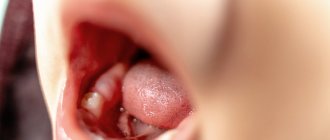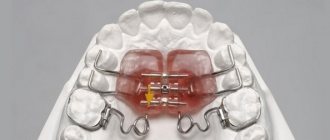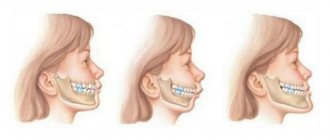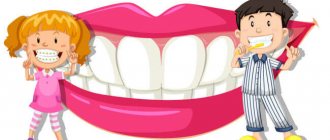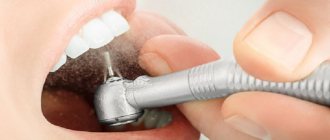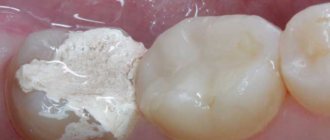After the first six months of life, baby teeth begin to appear. The norm is for all 20 baby teeth to erupt before the age of three. After another three years, the process of changing the dentition begins: baby teeth gradually fall out and give way to permanent ones - the so-called molars.
At a certain period of time, the child has both milk teeth, which have not yet fallen out, and permanent ones. This period is called the mixed dentition. At this time, children undergo active growth of the jaw bones and the formation of a permanent bite occurs.
It is the changeable bite that is the time when you should see a pediatric orthodontist to rule out possible malocclusions in the future or prescribe treatment if necessary.
Treatment of malocclusion using a partial 2x4 brace system.
In order to set the desired direction of tooth growth during the period of mixed dentition, a partial 2x4 bracket system is used. The name of the system is due to the mechanics of fastening the braces: the orthodontic apparatus is installed on 2 molars and 4 front incisors. It is the first molars (“sixes”) and 4 frontal incisors that appear first, replacing the milk teeth.
Treatment of malocclusion with a partial braces system can be carried out on both the upper and lower jaws.
The duration of treatment is limited to the period of transition from a mixed dentition to a permanent one. After all the teeth appear, if necessary, partial braces will be replaced with full ones.
On average, the 2x4 design is used between the ages of 8 and 10 years.
When is a mixed bite normal?
The following signs are considered the norm for a mixed dentition:
– the change of teeth begins at 6–7 years and is completed by 12–14 years;
– the roots of baby teeth dissolve over the previous 2–3 years, causing them to become loose and fall out;
- permanent units are formed under the milky ones, after they fall out - they begin to grow intensively, breaking through to the surface after 2-4 years. The final development and mineralization of permanent teeth occurs after 2–3 years;
– the jaw and dentoalveolar arch are actively growing, increasing in size;
– wide gaps appear between the teeth – this is the norm, since permanent teeth are larger than baby teeth and require more space.
Normally, baby teeth do not come into contact with permanent teeth. Otherwise, this is an anomaly caused by late loss of milk or early eruption of permanent ones. These cases are fraught with disruption of the functionality of the HFNS and require immediate contact with a dentist.
The importance of timely treatment of malocclusion
Childhood is a period when parents can become concerned about the problem of their child’s bite and solve it with “little effort” and at minimal cost. Ignored problems will result in more expensive and lengthy treatment in adolescence or adulthood.
Some consequences of malocclusion:
- inadequate chewing of food and, as a result, problems with the gastrointestinal tract;
- disruption of the respiratory system;
- uneven load when chewing can lead to accelerated “wear” and destruction of some teeth;
- possible problems with diction;
- increased risk of developing caries.
Milk bite
Two stages of development: the process of formation itself and the formed bite. For each stage there are deadlines in which dental units erupt in order. The timing is determined by human physiology.
Appearance sequence
Babies are born toothless, although the rudiments are already present inside the gums. The process of teeth emerging is usually accompanied by tears, periodontal swelling and increased body temperature.
Teeth begin to erupt when the baby is three to four months old. This process lasts approximately three years. These are conditional boundaries that depend on the individual characteristics of each child.
Teeth erupt in pairs: the lower pairs appear first, and only then the upper ones.
Sequence of appearance of baby teeth:
- The central incisors begin to erupt in the fifth month of the baby’s life and end in the ninth.
- The lateral incisors erupt between five and seven months.
- Molars appear at the age of about a year, the process can last up to one and a half years.
- Fangs erupt between thirteen and twenty months.
- The remaining molars appear starting from the twentieth month of a child’s life and finish erupting at the age of two and a half years.
- Premature babies' teeth may start to erupt later.
Temporary occlusion has several distinctive features, which can be divided into groups according to stages of development. Formation period:
- the lower jaw develops more slowly than the upper jaw;
- the dentitions are located symmetrically;
- paired teeth do not completely touch each other.
Formed temporary bite:
- teeth move away from each other due to the fact that the jaw itself becomes larger;
- pronounced abrasion of all units;
- free space appears behind the molars.
You need to take care of your oral cavity from the very first tooth. First, cleaning is carried out using a fingertip, and then using a brush. Clean baby teeth with special pastes that do not contain abrasive particles.
Many people believe that baby teeth do not need to be treated, since over time they will be replaced by permanent teeth. It's not like that at all. The milk bite affects the formation of the permanent one.
Consultation with a specialist in the formation of primary occlusion may be necessary in the following cases:
- if the teeth grow unevenly and they do not have enough space in the oral cavity;
- teeth do not erupt in a timely manner or the rudiments of milk units are absent;
- jaw injury;
- removal of molars.
Role of parents
In most cases, changing primary teeth does not cause any particular difficulties. But if a child complains of discomfort in the gums, you can use gels that have an analgesic effect, for example, Dentinox or Kalgel.
If instead of a baby tooth there is a wound on the gum that is bleeding, you can apply a ball of sterile cotton wool to it and hold it for about 5 minutes. After a temporary tooth falls out, it is forbidden to eat food for 2 hours. On that day, it is better not to give your child spicy, salty or sour foods.
If a molar has already broken through, but the baby tooth has not yet fallen out, it is better to use the help of a dentist rather than remove it yourself.
Methods of therapy for correcting bite
Correcting a bite most often means exclusively wearing braces. Indeed, they are often used (and not only for children), but other methods are also used in orthodontics. They can be divided into two groups - surgical and non-surgical.
Surgical methods
Surgical intervention is necessary in three cases:
- when there is high crowding, when it is necessary to remove quarter premolars to make room for other teeth;
- with serious jaw abnormalities;
- to speed up treatment.
Severe pathologies of the jaw bones, which lead to malocclusion and disturbances in swallowing and breathing, cannot be corrected without surgery. During the operation, the surgeon cuts the bone tissue in the places where the teeth need to be moved. At this time, the patient is under general anesthesia in the inpatient department. Rehabilitation after surgery takes up to three weeks. After the tissues are restored, the jaw will have to be developed. Most often, additional treatment is required: the doctor prescribes braces, which must be worn for at least six months. The type of braces, duration of wearing them, and location depend on the current state of the bite.
Surgery can also be used to shorten the treatment time for malocclusion. Orthodontists use what is called a corticotomy, a small operation performed after braces are installed.
About a week after installation, the patient comes to the periodontist, who uses a piezotome to make small incisions in the gums. The entire operation takes about 30 minutes and is performed under local anesthesia. Occasionally, sedatives are also used - general anesthesia is usually not needed.
After corticotomy, the patient will have to visit the orthodontist and periodontist several more times to remove sutures, monitor the condition of the gums and correct the braces. The operation significantly speeds up treatment – by 3–6 months.
Important: surgical intervention is prescribed only in adulthood, after the jaw is fully formed (usually after 16 years). There are a number of standard contraindications: HIV, cancer, heart disease, etc.
Treatment without surgery
If we are not talking about serious pathologies of the jaw, orthodontists and their patients do without surgical treatment methods. Correction of the bite occurs through the installation and long-term wearing of braces, mouthguards and other devices.
Braces are the most effective way to eliminate pathology. They are a power arch with brackets that are secured to the teeth. The arch provides constant pressure on the teeth, and they gradually move, taking the right place.
Braces are worn without interruption. They are removed only at an appointment with the orthodontist, during correction. Over the entire period of treatment (which ranges from 6 months to 3 years), several visits to the doctor may be required. The procedure and duration of treatment depend on the condition of the teeth and the chosen braces system. Thus, self-ligating ones do not require too frequent visits to the orthodontist.
In addition to braces, there are other methods of therapy. Thus, mouthguards are often used - removable devices made of transparent material, and if we are talking about three, microprosthetics (veneers) are chosen.
Why do temporary teeth fall out?
The process of changing elements of the dentition does not happen just like that. The appearance of the first teeth occurs between the ages of 6 and 9 months, when children begin to eat not only mother's milk, but also denser foods. At the same time, the dimensions of the maxillofacial apparatus are small, and therefore the dimensions of the first teeth are quite compact. Over the years, primary teeth are no longer able to perform chewing functions properly, and the jaw enlarges. As a result, it is able to accommodate all molars.
Prevention of pathologies
Prevention of mixed dentition defects begins in childhood and includes the following measures:
- breastfeeding, which ensures the correct physiological position of the lower jaw;
- choosing bottles with tight nipples for artificial feeding;
- refusal of nipples during teething;
- introducing solid food to a child from 6-8 months of age (active chewing contributes to the chewing load on the jaw);
- control of the child’s position in sleep;
- ridding the baby of bad habits;
- performing gymnastics for the lips and tongue;
- visit the dentist when the child reaches 1 year of age.
It is difficult to avoid genetic bite defects even if you follow preventive rules. In order to prevent the development of anomalies, they resort to the help of an orthodontist. At 3-4 years of a child’s life, a specialist may suggest grinding the cutting edges of the teeth.
Impaired eruption of permanent teeth
Parents should start to worry if there are no signs of eruption of a permanent tooth after the loss of a primary tooth for 5 or more weeks. There are several reasons why permanent teeth are “late” to appear:
- Adverse effects on the fetus and newborn baby. What matters are the damaging factors that affected the developing organism during pregnancy and in the first year of life. Illnesses of the mother and child, past infections, taking certain medications, and the consequences of birth trauma can prolong the eruption of permanent teeth.
- Absence or damage of a permanent tooth germ. The formation of teeth occurs in the 2nd trimester of pregnancy. As a rule, under the influence of unfavorable factors, the formation of an entire group or groups of teeth is disrupted. In this case, after the baby teeth fall out, there is no need to wait for permanent teeth to appear. Damage to the tooth germ is in most cases the result of careless dental treatment.
- Incorrect position of the tooth germ in the jaw bone. If the rudiment is located too deep in the tissues, oriented horizontally and not vertically, then tooth eruption will be difficult, if not impossible.
There are no external symptoms by which one could judge the cause of the disorder. You can only conduct an examination, based on the data of which a treatment plan is drawn up. For this, the child must be shown to the dentist. Perhaps, already at this stage, he will offer a consultation with a pediatric orthodontist, who, in turn, will prescribe treatment - orthodontic plates or a more modern and convenient method - aligners.
Causes of anomalies
For the correct formation of a permanent bite, it is necessary to monitor the condition of the teeth in early childhood. This means that the primary units also require careful care and dental treatment, just like the elements of the permanent dentition.
If you do not remove the caries-affected milk fragment in a timely manner, then there is a high probability that the entire dentition will begin to form asymmetrically.
The remaining units will move to the empty space area. As a result, the development of the alveolar process will slow down.
At 9-10 years of age, removal of milk units is considered justified. In this case, the development of bite pathologies is not observed.
By adolescence (12-14), the risk of malocclusion after tooth extraction increases again.
It is necessary to consider in more detail what can result from premature loss or removal of primary teeth.
Loss of incisors
Early loss provokes the mixing of the fangs in an anatomically incorrect position and the tilt of the remaining elements.
Deciduous incisors perform an important function - biting off pieces of food and redistributing the chewing load between all teeth.
In addition, the absence of incisors negatively affects a person’s appearance, since they are located in the smile zone.
You should know! Orthodontists consider premature loss of primary incisors to be a serious problem. Because of this, the remaining teeth are displaced relative to the center line of the face.
Displacement of elements relative to the center line is also observed with pathological abrasion of enamel and friction of teeth against each other.
Visual signs of senile progeny and pathology treatment tactics.
Let's talk here about measures to prevent malocclusions.
At this address https://orto-info.ru/zubocheliustnye-anomalii/okklyuzii/chto-takoe-sindrom-kostena.html all the most important things about the treatment of Kosten syndrome.
Loss of primary molars
Pathology also leads to a displacement of the row relative to the center line of the face. Children with an absent first painter should undergo regular dental examinations (at least once every six months).
Loss of second primary molars
The problem can cause the permanent molar to shift and create an abnormal bite.
If it was not possible to avoid the loss of a baby tooth, then parents need to regularly show the child to an orthodontist, who will decide on the need for treatment.
The main goal of therapy in this case is to preserve sufficient space for the full eruption of the permanent element.
To do this, a specialist may recommend wearing corrective devices that prevent the remaining teeth from shifting into empty space.
From the video, learn more about the dental problems that arise with mixed dentition.
Care instructions
Since the enamel is not yet fully formed during the eruption of molars, great attention should be paid to proper oral hygiene and preventive measures to prevent the development of caries.
- In the morning and evening, teeth should be brushed using a soft brush that does not damage the gums. Children are recommended to use special toothpastes with a high content of calcium and fluoride. It is better to brush your teeth under adult supervision, as children often do it too quickly and not thoroughly enough.
- All children should visit the dentist twice a year for an examination, professional cleaning, and timely detection and treatment of tooth decay.
- After any meal, children should rinse their mouths with plain water, a special baby mouthwash, or chamomile infusion. Thanks to this, plaque will not accumulate on the teeth and the likelihood of developing an inflammatory process in the eruption zone of the molar will decrease.
Price
The cost of correcting a bite is not limited to the installation of orthodontic structures. The therapy consists of successive stages, for each of which the patient is forced to pay:
- consulting a doctor and choosing the appropriate treatment method;
- diagnostic measures to identify contraindications to the procedure and measure jaw parameters;
- installation of devices selected in advance by the orthodontist;
- adjustment of orthodontic systems and their replacement;
- removal of fixed structures.
The cost of installing each orthodontic system should be considered separately:
- plates – 6,000–7,000 rubles;
- trainers – 7,000–10,000 rubles;
- mouthguards – from 15,000 rubles per set;
- braces from 16,000.
Nutrition during the period of changing baby teeth
The enamel of the molars is not fully formed when they erupt. This process lasts several years, so a nutritious diet with properly selected products is of great importance:
- Every day the child should eat food containing large amounts of calcium (milk and dairy products).
- In some cases, if the baby does not want to consume dairy products, it is recommended to take vitamins with a high calcium content.
- Fruits and vegetables, some of them should be consumed in solid form in order to more quickly dissolve milk roots and erupt molars.
- It is recommended to include fish dishes containing phosphorus in your diet twice a week. It is better to give children low-fat varieties, including pike perch, hake and pollock.
- Eliminate chocolate, white pastries and sweets from your diet. Sweet soda is considered the most dangerous for tooth enamel.
During the change of baby teeth, it is necessary to avoid the consumption of sticky or hard foods, including toffees, nuts and candies. Otherwise, you can damage the temporary tooth or cause it to fall out too early, which often causes problems in the growth of permanent teeth. In addition, children should not eat food that contains active dyes, which can negatively affect the color of the enamel of permanent teeth without the possibility of further changing it.
How to identify malocclusion
It is difficult to correctly determine correct and incorrect bite on your own. If the defect is pronounced, then there will be a visually noticeable deviation in the position of the teeth; in other cases, only an orthodontist can accurately determine the violation.
You can try to determine the deviation yourself as follows:
- stand in front of the mirror;
- close your jaws without tension;
- stretch your lips wide up and to the sides.
The reasons for contacting an orthodontist will be the following symptoms:
- one jaw is pushed forward;
- the upper lip protrudes;
- the edges of the dentition do not meet;
- noticeable displacement of the jaw to the side.
A visit to the orthodontist in this case is mandatory. Malocclusion is not only an aesthetic defect, but also the cause of multiple functional abnormalities and dental diseases.
Bite correction in adults
If you didn't receive orthodontic care as a child, it's not too late to get it later.
Adults and teenagers make up the remaining 3/4 of patients who get braces. Around age 11 or 12, most of the permanent teeth should be in the mouth. At this time, we can understand whether the teeth need to be straightened. When bite problems are present (because the bite was not corrected in childhood), they are more difficult to correct for both adolescents and adults, but this can be done with regular orthodontic appliances. In some cases, surgery may be performed to reshape areas of the mouth that have formed incorrectly. However, the need for bite correction and teeth alignment for adolescents and adults is obvious. Research shows that people perceive you as more successful, healthier, and happier if you have straighter teeth than if you have crooked teeth. You are more likely to get a job than someone with crooked teeth because your smile is an expression of your health and how well you take care of yourself. This can lead to how well you take care of other things, such as your obligations.
Research shows that in both adults and children, this confidence skyrockets and smiles appear more often when people feel good about their smiles. This boost in confidence can change your outlook on life and can lead you to become a more successful person than you might otherwise be. If you have teeth that need correction or bite straightening, don't hesitate to see what orthodontic care can do for you!
